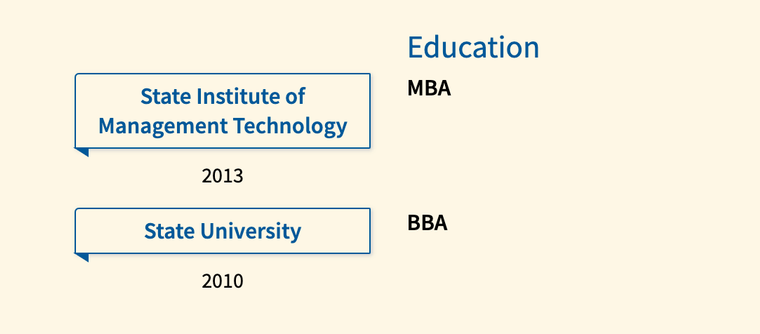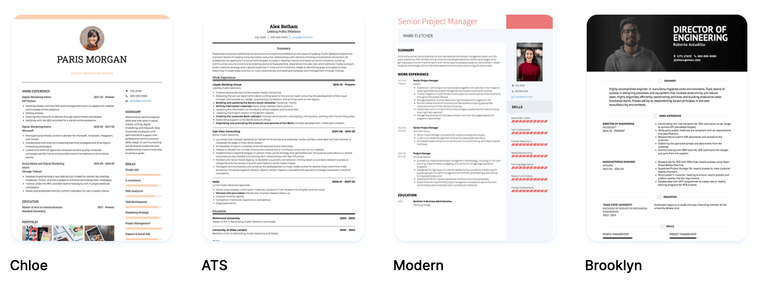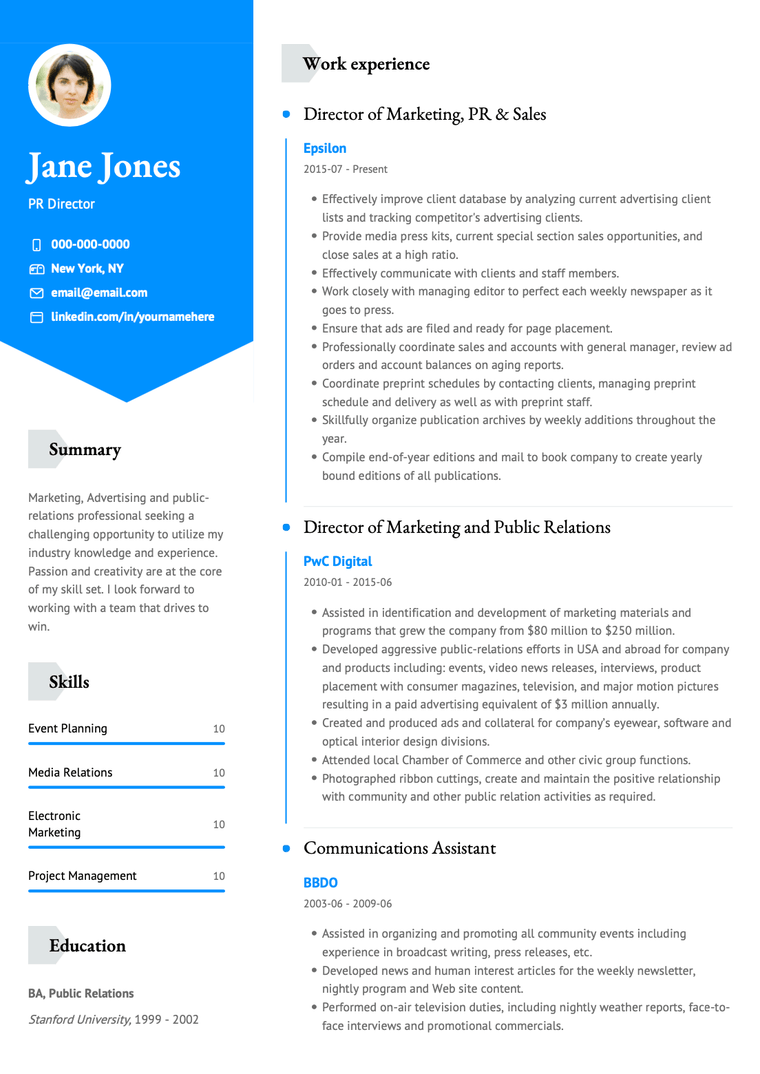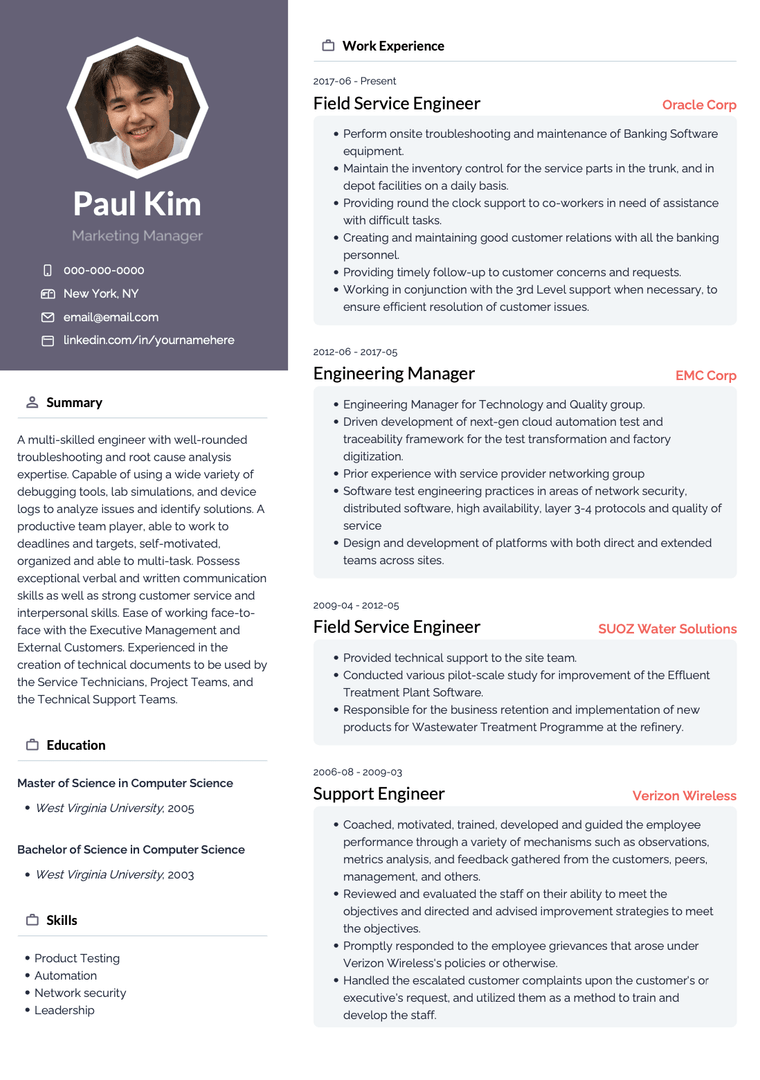
CV Basics: A checklist for writing a CV

It’s important to understand the CV basics when you begin your job search. Employers have particular things that they are looking for in a job candidate, and your CV needs to have what they want. Learning about the best practices for CV sections, CV formats, and CV writing will give you a head start in your job search.
Recommended links:
- Our collection of 500+ professional resume examples.
- Our gallery of 20+ downloadable resume templates.
To get ready for your next application, here are the CV basics you should consider:
What is a CV?
A curriculum vitae, usually called a CV, is a document that summarizes your work experience and professional qualifications. Job-seekers apply for jobs by sending their CV to companies with open positions. Employers then read the CVs and use them to decide who to invite for a job interview.
Exactly what your CV needs depends on your industry and location.
In North America, the term “CV” usually refers to a long, detailed document that gives a complete picture of your work history, education, research contributions, and published works. It is used almost exclusively by people in academia. It is distinct from the shorter, more customized “resume”.
In other countries, such as the UK, the terms “CV” and “resume” are used more interchangeably to refer to the shorter resume. CV is the most common term, and this type of CV is used to apply for most jobs.
When you begin writing your CV, make sure to research what CV specifications are required in the country you want to work in. Different countries have different work cultures and different job search norms, and your CV has to meet their needs.
CV basics checklist
To write a great CV, it’s best to start with the basics. Learning about the primary CV sections is a great place to begin.
These are the sections you’re likely to find on a CV:
Contact information
Your contact information is very important, and it comes first in the CV. Anyone reading your CV should know exactly who you are and how to contact you. Make sure your personal details are easy to find at the top of your CV.
In your Contact Information section, include your name, phone number, email address, and city.
Optionally, you can also add a job title, like Marketing Manager or Electrical Engineer, and a link to your personal website or LinkedIn profile. These details can help employers get a fuller picture of your skills right at the top of your CV.
In countries outside of North America, you may need to add more personal details, like your home address or your date of birth. When you write your CV, make sure you know what personal information is expected in the country you work in.

CV checklist: Contact information
- Name
- Phone number
- Email address
- City/address
- Headline (optional)
- Personal website (optional)
Summary
A Summary section, while not strictly mandatory, is a great way to introduce yourself to employers. This section is a short paragraph or bulleted list that highlights your key qualifications. It can describe your years of experience, your key skills, or some impressive achievements from previous roles. Anything you want to make sure employers know right away can go here. Your summary shouldn’t be more than a few sentences, but when it is written well this small section can have a huge impact.

CV checklist: summary
- Short and effective
- Highlights key qualifications
- Customized to suit role
Work Experience
For most job-seekers, the work experience section is the most important part of their CV. It’s the longest section, and the most prominent on the page. It summarizes the jobs you have held throughout your career.
In your Work Experience section, list your previous roles in reverse-chronological order, starting with your most recent position and working backwards. For each job, write the job title, company name, and the dates you held that position.
Underneath the job titles, provide a short description of each job. Using a bulleted list or a short paragraph, describe the role as impressively as possible.
For your Work Experience section to be effective, make sure each job description is more than just a boring list of your responsibilities. As you describe each job, try to focus on your achievements in the role, rather than your duties. Duties aren’t enough to stand out in a competitive job market.
In order to make your achievements clear, find successes that can be measured with numbers. Sales figures, customer happiness scores, and revenue growth that you contributed to all demonstrate that you have had measurable accomplishments in the past.
You should also use action words as much as possible. Your descriptions should make you seem like a motivated and efficient worker, and words like managed, demonstrated, and executed all help sell this idea.
For example, the phrase “Implemented Agile management processes in a 12-person development team” is more impressive than “Responsible for managing dev team”.
If you have changed jobs frequently, or have taken long breaks from work, you may find that a reverse-chronological CV doesn’t effectively showcase your skill set. If this is the case, you may want to consider writing a Functional or Combination CV. You can read more about these formats in the CV Formats section.

CV checklist: Work Experience
- Job title
- Company name
- Dates of employment
- Reverse-chronological order
- Quantifiable information
- Active language
- Relevant to the job posting
Education
For most job-seekers, your Education section can be relatively short. It does not need the same amount of attention as the Work Experience section.
In your Education section, list the degree name, the school name, and the date the degree was awarded.
If you’ve been in the workforce for a few years, this is enough information. Your education is an important step in your career journey, but employers are more interested in your achievements in recent jobs. Keep your education section short and sweet.
If you’re a student or recent graduate, however, and you don’t have much work experience to display, you may want to place more emphasis on your Education section. If this is the case, you can include details like relevant coursework, your GPA (if it’s high), or research specialization. You can make up for a lack of work experience with relevant and impressive academic achievements.
If you’re writing an academic CV, or a CV for a research position, your Education section is more important. In these cases, you should be more descriptive with your Education, and include details about your thesis, your coursework, and important research projects.

CV checklist: Education
- Degree or diploma
- School name
- Date awarded
- Additional details (optional)
Skills
Ultimately, employers are looking for your skill set. A Skills section is a great way to showcase your abilities and let employers know what you can do for them.
Use a bulleted list to display your skills. Lists are easy to read and don’t take up very much space on the CV. If your list of skills is too long, use a table to keep it neat and tidy.
For a more visual flair, use strength ratings in your Skills section. This draws the eye, and shows that you’re confident in your abilities.
Make sure your skills are perfectly targeted for the position. Every skill should be relevant to the job you’re applying for. Every time you apply for a job, think of your most relevant skills and prioritize those.

CV checklist: Skills
- Well-formatted list
- Your most impressive abilities
- Highly relevant to the job
Publications
If you’re writing an academic CV, a Publications section is integral. The research, books, and journal articles you have contributed to are just as important as your education and work experience. When you apply for academic positions, your publications section has to be perfect.
Use clear, readable organization and the appropriate style for your publications section, and list items in reverse-chronological order. Different academic fields have different expectations for citations, so make sure yours are using the correct format.
If you aren’t in an academic field, a publications section likely isn’t necessary. In any other career, published writing samples will fit better in a Portfolio or Writing Samples section.
CV Checklist: publications
- Detailed
- Properly cited
- Organized by date
Volunteering
Volunteering experience can be just as important as work experience. It may not be paid work, but it’s still experience where you collaborated with people, developed skills, and belonged to an organization. All of these things can help show that you’re a skilled and dedicated worker.
In your volunteering section, include the name of the position you held, the name of the organization, and the dates you volunteered.
If your participation was casual, that information is enough. If you held an important or involved position, write a description as well. If the experience is impressive and relevant, you can treat the description like you would a job description, with active language, quantifiable information, and a focus on accomplishments.
CV Checklist: Volunteering
- Job title
- Organization name
- Dates
- Description of responsibilities
Certifications
Not all certificates and licences fit in an Education section. Even if you went to school or took classes to get certified in a particular skill, a separate section for certificates can be useful. For example, if you have a ticket in a skilled trade or a particular drivers license required by the job, you can add it to your Certifications section. This makes it easier for the employer to scan your resume and see that you’re properly licensed for the position.
In your certifications section, include the certification and, if appropriate, the organization you earned it from. Additional descriptions usually aren’t needed in this section.
CV Checklist: Certifications
- Certification
- Organization name
Other sections
While the sections described above are more than enough for most job-seekers, your CV belongs to you, and you can add any section you want if you feel it will help your application. Additional sections may include:
Languages
If you only speak one language in a monolingual area, listing that language isn’t necessary. If you’re multilingual, however, the languages you can speak may be an asset to your CV. You never know when familiarity with another language can help you, especially if the role involves communicating with customers.
Interests/hobbies
While this isn’t relevant in most applications, if you have a particularly impressive or relevant interest it may help your CV. For example, if you’re an electrical engineer and you make robots in your free time, that would likely be something a hiring manager would like to see on your CV. Your love of playing video games, however, is probably not worth mentioning.
Memberships
The organizations you belong to can reflect well on your candidacy. If you’re a member of any professional development organizations, mentorship programs, or educational organizations, for example, be sure to include these in your CV. Professional associations like this show that you’re involved in your community and willing to dedicate your free time to improving it.
Organizations that aren’t as relevant, like a local sports league or social club, can be left off your resume unless you hold an important position there. If you’re the president, treasurer, or something similar, however, your membership can be an example of your leadership or organizational skills.
Conferences
Professional conferences you have attended or spoken at may be an asset to your CV. Conference participation can show that you’re involved in your professional community and dedicated to learning and improving throughout your career.
Tips for writing your CV
Once you have all the CV basics in place, you can move on to the next steps. To do this right, here are a few important tips for writing a great CV:
Pick a CV template
The appearance of the CV is just as important as the text. Your CV should be professional, readable, and attractive.
The perfect CV template for you depends on your field and your career. If you’re applying for a corporate job at a traditional company, you should use a traditional CV template. If you’re in a more artistic field, like photography or design, you can use a more creative template.
Whether you’re a lawyer or a musician, however, there are certain design guidelines to keep in mind. Make sure your CV is easy to navigate and easy to read. It should have clear headings and a font that you don’t have to squint to understand. If you use colour, make sure the colour is complementary and doesn’t distract from the content. Your CV has to look good, but the appearance shouldn’t overshadow your qualifications.
Fortunately, you don’t have to rely on your own design skills to make an eye-catching CV. When designing your resume, look for an online CV builder that offers professional CV templates suitable for your career and your industry. A great CV building tool makes the work of making your CV look great much easier, whether you’re in a creative field or a corporate one.

Customize your CV
Every time you apply for a different job, you should be customizing your CV. Every job posting is asking for specific skills and experience, and your CV should be targeted to meet those requirements. The perfect CV for one application won’t be perfect for any others.
To properly customize your CV, you need to carefully research the job you’re applying for. The job posting will be asking for particular skills, and your CV should make it clear that you have them. Use the same words as the job posting to describe your skills and experience so the employer can tell that you have exactly what they’re looking for.
You should also research the company itself. Look online for things like the company mission and values, as well as corporate leadership and market position. Check social media sites for company accounts, like LinkedIn, Twitter, and Instagram, to get a sense of what the company is interested in and what company culture is like. With this knowledge you will not only be better informed in general, but you will be able to customize your resume to show that you will fit right in at this company. Being a good culture fit is almost as important as being skilled.
It can also help to research the wider industry. You should know what skills are in demand and what a typical career in your field looks like. This can help you write your CV and may even affect the types of jobs you apply for.
You should also research the company itself. Look online for things like the company mission and values, as well as corporate leadership and market position. Check social media sites for company accounts, like LinkedIn, Twitter, and Instagram, to get a sense of what the company is interested in and what company culture is like. With this knowledge you will not only be better informed in general, but you will be able to customize your resume to show that you will fit right in at this company. Being a good culture fit is almost as important as being skilled.
It can also help to research the wider industry. You should know what skills are in demand and what a typical career in your field looks like. This can help you write your CV and may even affect the types of jobs you apply for.
Beat the Applicant Tracking System
Most companies use an applicant tracking system, or ATS, to manage their applications. If you are applying for a job online, your CV is almost certainly being run through an ATS.
ATS is a software that reads CVs and sorts them according to how well they meet the job requirements. Today, most companies use an ATS as the first step in their hiring process. Every CV that a job-seeker submits online is read by an algorithm before it is read by a person.
The ATS doesn’t send every CV it receives further down the hiring pipeline, however. For your CV to be sent to a hiring manager, you need to make sure it has what the ATS is looking for.
To ensure you make it past the ATS, it’s important to make sure your CV is easy to parse. Stick to simple templates with clear headings, a straightforward structure, and readable format. VisualCV’s Standard, Monaco, and ATS templates, for example, are designed to be easy to read. Avoid complicated visual items like tables and pictures, which may be difficult for the ATS to parse.
(This doesn’t mean you have to stick with simple templates in all situations. Feel free to bring a more colourful template to the interview, or use one when applying by email instead of an online submission form.)
Once you’re sure the ATS will be able to read your CV, you should customize it to suit the job posting. The ATS will be looking for keywords, and the CVs that best match the keywords will be passed along to the hiring manager.
Read the job posting closely, and make sure your CV has all the skills it asks for (as long as it’s true!). The ATS will likely use the text of the job posting as keywords, so use the same language to describe your experience as much as possible. For example, if the posting asks for experience with Adobe Illustrator, make sure your CV says Adobe Illustrator, not Adobe Creative Suite. The specific keywords are important to the ATS.
This doesn’t mean you can trick the ATS, however. Copying the text of the job posting word for word, or adding extra keywords in an invisible font, is not going to fool the software. The ATS accounts for tricks like this, and if you somehow got past the ATS, the hiring manager would reject your CV anyway when they realize the ruse.
CV Format
The vast majority of CVs use reverse-chronological format. This CV format emphasizes the Work Experience section, and lists past roles by beginning with your most recent position at the top and working backwards in order. In reverse-chronological CVs, the Work Experience section is the largest section and each job is described in some detail.
For most job seekers a reverse-chronological CV format is the best choice. This is the format that suits most careers, and it is the format that employers are expecting to see.
If you’ve had a less conventional career path than most job-seekers, however, you may not want to emphasize your work experience over your other qualifications.
For example, if your work history has long gaps in it, or if you have a history of job-hopping, you may want to make your Skills section the most important part of the resume instead of the Work Experience section. This doesn’t mean you can try to hide your career path; rather, it means you can make sure employers see the most important thing first: your skills.
If this is the case, you may want to write a Functional or Combination CV.
A Functional CV, sometimes called a skills-based CV, emphasizes skills over everything else in the CV. In this format the Skills section is the largest section, placed at the top of the CV. In that section you can list skills, and even add explanations or examples from your career that showcase your expertise in that skill. The Work Experience can be shorter, with brief job descriptions or none at all, and instead of sorting jobs in order they can be organized by topic. For example, you could have a section for Web Development Experience and a brief section for Other or Previous Experience.
Using the Functional CV is a risky choice. While there’s nothing wrong with emphasizing your skills, the unconventional work history presentation can make some employers suspicious. When the timeline of your career isn’t clear, it might look like you’re trying to hide something. The purpose of a skills-based CV isn’t to hide your career; it’s to emphasize your skills.
A Combination CV combines the best features of the Functional CV format and the reverse-chronological CV. Like the Functional format, it emphasizes the Skills section, but it maintains the ordered Work Experience section of the reverse-chronological format. The Work Experience section can still be smaller, but the timeline of your career will still be easy to understand. This format allows you to emphasize your skills without creating confusion in your Work Experience section.
If you decide to use a CV format besides the typical reverse-chronological resume, it should be the Combination CV. This allows you to showcase your skills without obscuring your career path.
CV Examples
See the CV basics in action in these professional CV examples.
PR Director CV Example

Summary
Marketing, Advertising and public-relations professional seeking a challenging opportunity to utilize my industry knowledge and experience. Passion and creativity are at the core of my skill set. I look forward to working with a team that drives to win.
Skills
- Event Planning
- Media Relations
- Electronic Marketing
- Project Management
Work experience
Director of Marketing, PR & Sales
Epsilon
- Effectively improve client database by analyzing current advertising client lists and tracking competitor's advertising clients.
- Provide media press kits, current special section sales opportunities, and close sales at a high ratio.
- Effectively communicate with clients and staff members.
- Work closely with managing editor to perfect each weekly newspaper as it goes to press.
- Ensure that ads are filed and ready for page placement.
- Professionally coordinate sales and accounts with general manager, review ad orders and account balances on aging reports.
- Coordinate preprint schedules by contacting clients, managing preprint schedule and delivery as well as with preprint staff.
- Skillfully organize publication archives by weekly additions throughout the year.
- Compile end-of-year editions and mail to book company to create yearly bound editions of all publications.
Director of Marketing and Public Relations
PwC Digital
- Assisted in identification and development of marketing materials and programs that grew the company from $80 million to $250 million.
- Developed aggressive public-relations efforts in USA and abroad for company and products including: events, video news releases, interviews, product placement with consumer magazines, television, and major motion pictures resulting in a paid advertising equivalent of $3 million annually.
- Created and produced ads and collateral for company’s eyewear, software and optical interior design divisions.
- Attended local Chamber of Commerce and other civic group functions.
- Photographed ribbon cuttings, create and maintain the positive relationship with community and other public relation activities as required.
Communications Assistant
BBDO
- Assisted in organizing and promoting all community events including experience in broadcast writing, press releases, etc.
- Developed news and human interest articles for the weekly newsletter, nightly program and Web site content.
- Performed on-air television duties, including nightly weather reports, face-to-face interviews and promotional commercials.
Education
BA, Public Relations
Stanford University
Field Service Engineer CV Example

Summary
A multi-skilled engineer with well-rounded troubleshooting and root cause analysis expertise. Capable of using a wide variety of debugging tools, lab simulations, and device logs to analyze issues and identify solutions. A productive team player, able to work to deadlines and targets, self-motivated, organized and able to multi-task. Possess exceptional verbal and written communication skills as well as strong customer service and interpersonal skills. Ease of working face-to-face with the Executive Management and External Customers. Experienced in the creation of technical documents to be used by the Service Technicians, Project Teams, and the Technical Support Teams.
Work Experience
Field Service Engineer
Oracle Corp
- Perform onsite troubleshooting and maintenance of Banking Software equipment.
- Maintain the inventory control for the service parts in the trunk, and in depot facilities on a daily basis.
- Providing round the clock support to co-workers in need of assistance with difficult tasks.
- Creating and maintaining good customer relations with all the banking personnel.
- Providing timely follow-up to customer concerns and requests.
- Working in conjunction with the 3rd Level support when necessary, to ensure efficient resolution of customer issues.
Engineering Manager
EMC Corp
- Engineering Manager for Technology and Quality group.
- Driven development of next-gen cloud automation test and traceability framework for the test transformation and factory digitization.
- Prior experience with service provider networking group
- Software test engineering practices in areas of network security, distributed software, high availability, layer 3-4 protocols and quality of service
- Design and development of platforms with both direct and extended teams across sites.
Field Service Engineer
SUOZ Water Solutions
- Provided technical support to the site team.
- Conducted various pilot-scale study for improvement of the Effluent Treatment Plant Software.
- Responsible for the business retention and implementation of new products for Wastewater Treatment Programme at the refinery.
Support Engineer
Verizon Wireless
- Coached, motivated, trained, developed and guided the employee performance through a variety of mechanisms such as observations, metrics analysis, and feedback gathered from the customers, peers, management, and others.
- Reviewed and evaluated the staff on their ability to meet the objectives and directed and advised improvement strategies to meet the objectives.
- Promptly responded to the employee grievances that arose under Verizon Wireless's policies or otherwise.
- Handled the escalated customer complaints upon the customer's or executive's request, and utilized them as a method to train and develop the staff.
Education
Master of Science in Computer Science
West Virginia University
Bachelor of Science in Computer Science
West Virginia University
Skills
- Product Testing
- Automation
- Network security
- Leadership

Written By
Ben Temple
Community Success Manager & CV Writing Expert
Ben is a writer, customer success manager and CV writing expert with over 5 years of experience helping job-seekers create their best careers. He believes in the importance of a great resume summary and the power of coffee.

Get the most out of your job search by making sure your professional CV format is perfect.
August 11, 2021
Read Post

Community Success Manager & CV Writing Expert

Learning how to write a resume in 2024 is an important step in everyone's career. With this step-by-step guide, you'll have a great resume in no time.
December 6, 2023
Read Post

Community Success Manager & CV Writing Expert

CV Photo Advice and Tips: Should your CV have a photo?
June 26, 2020
Read Post

Co-Founder & Director
Copyright ©2024 Workstory Inc.